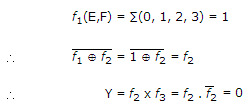Electronics and Communication Engineering - Exam Questions Papers - Discussion
Discussion Forum : Exam Questions Papers - Exam Paper 2 (Q.No. 18)
18.
Find Y in the circuit below :
f1(E, F) = ∑(0, 1, 2, 3)
f2(A, B, E, F) = ∑(0, 1, 2, 3, 5, 6, 9)
f3(A, B, E, F) = ∏(4, 7, 8, 10, 11, 12, 13, 14, 15)

f1(E, F) = ∑(0, 1, 2, 3)
f2(A, B, E, F) = ∑(0, 1, 2, 3, 5, 6, 9)
f3(A, B, E, F) = ∏(4, 7, 8, 10, 11, 12, 13, 14, 15)

Answer: Option
Explanation:

Discussion:
4 comments Page 1 of 1.
Angel said:
8 years ago
I don't understand this problem can someone take initiative and explain the problem?
Raviraj said:
8 years ago
In f3 pos is given but if we change it into its sop form then f2 and f3 will be identical.
Praveen said:
8 years ago
Since f1 has two variables E, F and it has all variables in the summation. So f1 (E, F) = 1 and 1 exclusive nor f2 becomes f2. Therefore why = f2*f3 = f2*f2' = 0. (since f3 is the inverse of f2, given in pos form).
Milan singh said:
9 years ago
I don't understand this problem. Can anyone explain it in simple way?
Post your comments here:
Quick links
Quantitative Aptitude
Verbal (English)
Reasoning
Programming
Interview
Placement Papers